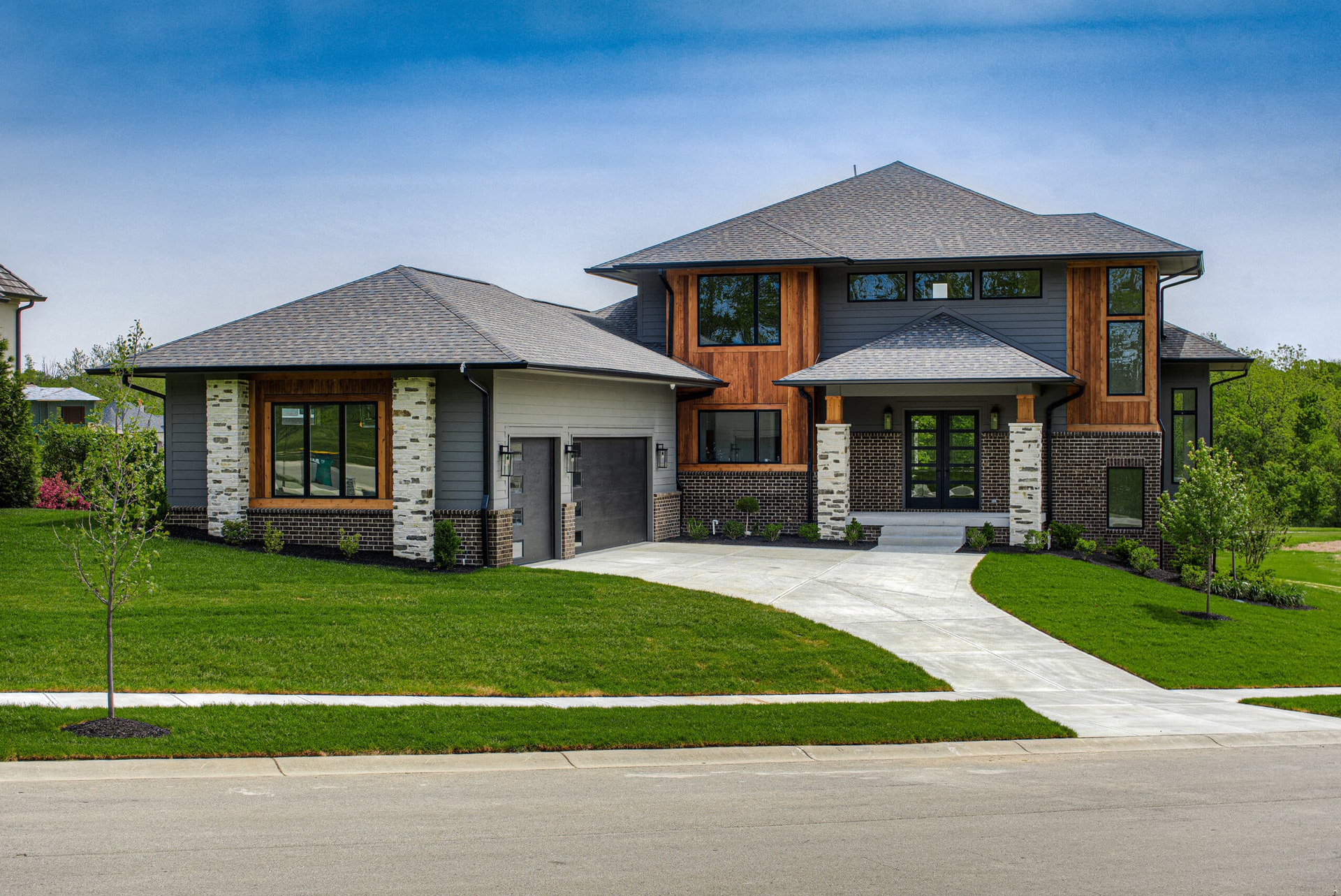In Zionsville, subtle finishes win. Walk through custom homes by Old Town Design Group, Wedgewood, Gradison, and Integra, and you’ll notice a common thread: luxury that whispers rather than shouts. Primary bedrooms in communities like Holliday Farms, Wild Air, and Shannon Springs embrace quiet sophistication over heavy patterns or bold statements. The result feels timeless, restful, and undeniably upscale.
The challenge with primary suites in luxury Zionsville homes isn’t space. These rooms are generous. It’s creating wall treatments that feel intentional without overwhelming the serenity these spaces need. Heavy wallpapers can dominate. Bold colors can energize when you need calm. Busy patterns can create visual noise in rooms designed for rest. Smart wall treatments solve this by adding architectural interest through proportion, texture, and subtle contrast rather than pattern or color.
We use slim-profile moldings, perfect proportions, and soft contrast paint to create quiet-lux primary suites that complement custom builds by these top-tier builders. From narrow-stile picture molding with museum-quality spacing to integrated headboard ledges that feel built-in, these six approaches add luxury without sacrificing the peaceful atmosphere primary bedrooms need.
Narrow-Stile Picture Molding with Museum Spacing
Traditional picture molding can feel heavy in primary bedrooms where serenity matters most. Narrow-stile profiles—typically 1.5 to 2 inches wide create architectural definition without visual weight. The key lies in museum-quality spacing that follows proportion rules developed for displaying fine art, translated to residential wall treatments.
Museum spacing principles dictate that frame proportions should relate mathematically to wall dimensions and ceiling height. In Zionsville primary suites with 10-foot ceilings, frames measuring 24 by 36 inches create elegant vertical emphasis that draws the eye upward without overwhelming horizontal space. The spacing between frames should equal roughly one-quarter of the frame width, creating rhythm without crowding. Old Town Design Group and Wedgewood homes with these proportions achieve gallery-like sophistication that never feels busy.
Installation precision determines whether narrow-stile molding reads professional or amateurish. Corners must be perfectly mitered, profiles must run consistently parallel to floor and ceiling lines, and paint must eliminate any evidence of joints or nail holes. When executed properly, these treatments look like original architectural details rather than added trim. The subtlety creates rooms that feel custom without calling attention to the craftsmanship itself, the essence of quiet luxury design.
The color approach matters tremendously with narrow-stile treatments. Painting molding and walls in the same color creates shadow-line definition without contrast that might feel busy. Alternatively, using white molding against soft neutrals like warm grays or gentle beiges provides definition while maintaining serenity. Gradison and Integra primary suites benefit from this restrained palette that supports rest rather than stimulation.
Integrated Headboard Ledge Inside Panel Systems
Creating built-in headboard elements within wall panel systems eliminates the need for separate furniture while adding architectural substance. This approach works especially well in Zionsville’s custom homes where primary suites are generous enough to support substantial wall treatments without feeling cramped.
The ledge itself becomes both functional and decorative, providing surface space for bedside essentials while creating a defined sleeping alcove. Proper proportions place the ledge 36-40 inches above the floor, high enough to clear standard mattress heights while remaining accessible for table lamps or personal items. The depth should measure 8-12 inches to provide meaningful surface area without protruding awkwardly into the room. Wedgewood and Old Town Design Group primary suites often feature these proportions.
Panel integration requires careful planning to ensure the headboard ledge feels like part of the overall wall composition rather than an afterthought. Vertical panels flanking the bed should be sized to frame the sleeping area without extending beyond the bed’s footprint. This creates visual boundaries that define the sleeping zone while maintaining open feeling in the rest of the room. The ledge should align with horizontal elements in the panel grid, creating coherent architectural rhythm.
Hidden lighting beneath the ledge adds both function and ambiance. LED strips concealed in routed channels provide gentle uplighting that eliminates harsh shadows while creating subtle drama behind the bed. This lighting can be dimmed for evening reading or brightened for morning routines. When integrated during construction, the electrical work remains completely hidden, contributing to the seamless appearance that characterizes quality custom work.
Matching Trim Language Into Ensuite Doorways
Continuity between primary bedroom wall treatments and adjacent ensuite bathrooms creates visual flow that makes both spaces feel larger and more cohesive. This requires extending trim profiles, proportions, and design vocabulary into doorway casings and beyond.
Doorway casing details become critical transition elements. If bedroom walls feature narrow-stile picture molding, the ensuite doorway should incorporate similar proportions and profiles. This might mean custom-milling casing profiles that echo the bedroom’s molding dimensions, or incorporating panel details within the door surround itself. Integra and Gradison homes benefit from this attention to continuity that prevents rooms from feeling disconnected despite different functions.
Color transitions require thoughtful planning to maintain cohesion without monotony. Carrying the bedroom’s wall color into the ensuite entryway creates seamless flow, while transitioning to spa-like tones deeper in the bathroom maintains appropriate ambiance for each space. The doorway becomes a gradual transition rather than an abrupt change, supporting the quiet luxury aesthetic that avoids jarring contrasts.
Sightline management determines how successfully the rooms integrate visually. When bedroom wall treatments align with ensuite elements visible from the bed, the spaces read as unified rather than separate. This might mean positioning mirror frames to echo bedroom panel proportions, or ensuring towel bar heights coordinate with bedroom ledge or chair rail lines. These details seem minor individually but collectively create the seamless integration that characterizes professionally designed spaces.
Soft Contrast Paint Applications for Subtle Definition
Quiet luxury relies on tonal variation rather than bold color contrasts to create visual interest. Soft contrast techniques use closely related paint colors to define architectural elements without creating busy or overwhelming effects.
Tonal painting approaches work exceptionally well with panel systems where molding and wall fields can be differentiated through subtle color shifts. Using the same base color in different sheens—perhaps flat on wall areas and eggshell on trim—creates definition through light reflection rather than color contrast. This technique works beautifully in Zionsville primary suites where natural light changes throughout the day, revealing different aspects of the treatment as lighting conditions shift.
Color depth variations offer another sophisticated approach. Using paint colors that are 2-3 shades apart on the same color strip creates gentle definition that reads as intentional design rather than stark contrast. Warm grays ranging from “dove” to “greige” tones, or beiges progressing from “linen” to “mushroom” provide enough variation to define elements while maintaining serene atmosphere. Old Town Design Group and Wedgewood projects often employ these subtle progressions.
Professional color matching ensures consistency across different paint applications and lighting conditions. Custom-mixed paints prevent the slight variations that can occur with off-the-shelf colors, while high-quality paint provides durability and consistent appearance over time. The investment in premium materials supports the luxury positioning while ensuring treatments maintain their appearance through years of daily use.
Textural Elements Without Pattern Complexity
Adding texture through materials and finishes creates visual interest without the busy-ness that patterns can introduce to primary bedroom spaces. Textural approaches support quiet luxury by providing tactile richness that feels expensive without being ostentatious.
Grasscloth wallcoverings offer natural texture that adds warmth without pattern. Applied to accent walls behind beds or within panel systems, grasscloth provides subtle variation that changes appearance with lighting throughout the day. The natural fibers create depth that paint alone cannot achieve, while neutral colorations maintain the serene palette appropriate for rest spaces. Quality grasscloth installation requires professional expertise to ensure seams are invisible and the material hangs properly.
Venetian plaster applications create sophisticated texture through subtle variation in surface relief and light reflection. Applied over base wall preparation, quality plaster work provides organic texture that feels luxurious without being flashy. The technique allows color and texture integration in single applications, simplifying the overall composition while adding substantial visual interest. Gradison and Integra primary suites often feature these artisanal finishes.
Fabric wall treatments provide ultimate luxury through texture, acoustics, and visual warmth. Upholstered panels installed within molding systems add softness that supports rest while providing sound absorption. Fabric selection should emphasize texture over pattern—linen weaves, wool textures, or silk surfaces provide richness without visual complexity. Installation requires professional expertise to ensure panels remain taut and aligned over time, but the results provide unmatched luxury feeling.
Crown Molding Proportions for Quiet Elegance
Crown molding in quiet luxury applications requires restraint and precision rather than elaborate profiles or excessive scale. The goal is creating definition that feels intentional without calling attention to itself.
Profile selection should emphasize clean lines over complex curves or multiple steps. Simple cove profiles or geometric crown shapes provide architectural definition without visual noise. The scale should relate to ceiling height—4-inch profiles work well with 9-foot ceilings, while 5-6 inch crowns suit 10-foot heights common in Zionsville custom homes. Old Town Design Group and Wedgewood homes often feature these proportional relationships.
Installation quality determines whether crown molding enhances or detracts from quiet luxury goals. Joints must be perfectly tight, profiles must run consistently level, and paint preparation must eliminate any evidence of construction details. Coping inside corners and scribing to ceiling irregularities requires skilled craftsmanship, but proper execution creates seamless appearance that supports luxury positioning.
Color treatment should support overall wall composition rather than creating contrast. Painting crown molding to match ceiling color creates subtle definition through shadow lines rather than color contrast. Alternatively, matching crown color to wall treatments maintains monochromatic harmony while providing architectural definition. The approach should support rest and relaxation rather than creating visual excitement that interferes with sleep.
Why Subtle Wall Treatments Work in Zionsville Primaries
Zionsville’s custom home buyers choose the area for its sophisticated, understated character. Communities like Holliday Farms and Wild Air attract residents who appreciate quality over flash, craftsmanship over trends. Primary bedroom wall treatments should reflect these values by providing luxury that enhances daily life without demanding constant attention.
The quiet luxury approach aligns perfectly with how primary bedrooms actually function. These rooms need to support rest, relaxation, and intimacy—functions that benefit from calm, serene environments rather than visually stimulating ones. Wall treatments that whisper rather than shout create appropriate backdrops for quality sleep and peaceful mornings.
Builder relationships with Old Town Design Group, Wedgewood, Gradison, and Integra ensure these treatments integrate seamlessly with existing architectural vocabulary established throughout custom homes. Rather than fighting existing design elements, subtle wall treatments complement and enhance the investment families have made in quality construction and thoughtful design.
Ready to Transform Your Zionsville Primary Suite?
At Radford Woodworks, we specialize in quiet luxury wall treatments that complement Zionsville’s finest custom homes. Our experience with Old Town Design Group, Wedgewood, Gradison, and Integra builds ensures seamless integration with existing architectural elements while adding the subtle sophistication these homes deserve.
Explore our Gallery Page to see completed Zionsville primary suite transformations, then fill out our form to get your personalized quote at radfordwoodworks.com/contact.
Your primary suite should be a sanctuary. Let’s create wall treatments that support that vision with quiet luxury that lasts.






